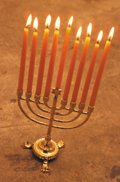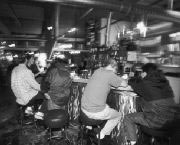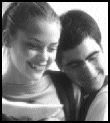I was “working” a Passover Seder supper with my dad at the chapel at Fort Lewis. My job was to poke my head out the front door—on cue—to see if the prophet Elijah had returned aboard his flaming chariot to join us for dinner. The double whammy of growing up both a preacher’s kid and an Army brat carried with it many strange and wonderful responsibilities. (And the irony of my dad—a Southern Baptist chaplain who had grown up watching his dad preside over Three-Hole Swamp Baptist Church—officiating at a Jewish Seder. Well, that was just the sort of thing you accepted as a matter of course in the Army.) As a 12-year-old still into Thundarr the Barbarian and role-playing wizards, I hadn’t quite ruled out that Elijah might show up. I remember bracing myself hopefully for the potential heat and glare of his chariot. Prophet or no prophet, I could sense the importance of the evening and feel the gravity of the ritual. At every Seder, a place is set for Elijah, because you never know when the old guy will come back from heaven.
The Seder also commemorates the Jews’ exodus from Egypt: Every part of the meal holds symbolic meaning. Haroseth, a mixture of chopped walnuts, wine, cinnamon, and apples, represents the mortar Jewish slaves used to build the Pharaoh’s bricks; parsley represents springtime, but it’s dipped in salt water to evoke the tears of slavery; a shank bone stands for the sacrificed lambs which allowed Jewish families to duck the Angel of Death; and bitter herbs (fresh horseradish, in this case) reminded us of a slave’s bitter life. Elijah never showed, but I still count my sentry duty as one of the more surreal moments of growing up the son of a chaplain. The exposure to different cultures, and different religions, left its mark. Religious rituals do convey a potent and palpable power—even (and sometimes especially) when you’re not a member of a particular religion. And when food is added to the mix, whether it’s broken bread or horseradish or even just the act of fasting, that power is somehow multiplied.
Over the next month or so in Seattle, you’ll get quite a few chances to sit down with people who are celebrating the holidays—in churches, temples, mosques, and even out in the woods. You might be reluctant to attend these events, worried that you’ll be considered a dilettante or, worse, an interloper. But more often than not, people appreciate “outsiders” who show a sincere interest in learning about their culture and beliefs. And respectfully observing somebody else’s religious feast or holiday—regardless of your own beliefs—can be eye-opening, and it can make your own holiday that much richer. My dad talks about “the strong, universal hunger of human beings for a connectedness to our creator”; I just know that even though I’m not Jewish, a crisp potato latke that’s prayerfully prepared around Hanukkah can satisfy me in mysterious ways. Following is just a handful of the celebrations of prominent religious holidays occurring soon in or near Seattle. Conventional self-help wisdom recommends that you check out both those that appeal to you most and those that you strongly resist.
The first candle of Hanukkah was lit after sundown on December 3 (or, more accurately, the 24th of Kislev). The eight-day “Festival of Lights” celebrates the miraculous victory of the Jews over Greek persecution. After giving the Greeks the boot from Jerusalem, they rededicated the holy temple but found only a small flask of oil there to light the Menorah. In yet another miracle, the flask lasted eight days. Watch for latkes (potato pancakes) and sufganiot (doughnutlike creations)—these fried foods remind us of the temple’s miraculous oil. You’ll also come across a lot of cheese and dairy products to commemorate the heroism of the beautiful Yehudis. (You’ll have to ask how she lifted the siege of Jerusalem with cheese, wine, and a beheading.) To find out about Hanukkah-related events, look up www.jewishinseattle.org/ on the Web.
Ramadan, the ninth month of the Islamic calendar, commemorates when the Holy Koran was sent down from heaven and represents a time of worship and contemplation for the Islamic community. Muslims fast from sunup to sundown for the entire month, which begins around December 9 and ends sometime around the 8th of January with the Id-al-Fitr, the Feast of Fast Breaking. This quiet, solemn holiday is marked only by nightly prayer and fast breaking at local mosques, which non-Muslims are welcome to attend; even the Id-al-Fitr (the “ead”) will likely be a somber occasion for the 15,000 to 20,000 Muslims living in and around Seattle. For more information, call a mosque near you (Northgate Mosque, 363-3013; Dar-ul-Arqam in Lynnwood, 425-774-8852; Islamic Center of the Eastside, 425-746-0398). Check out www.arabview.net-/Ramadan/ to see recipes for nightly Ramadan meals.
Christmas, the big C of December, probably the most inconsistently celebrated holiday around, arrives December 25—although parts of the Orthodox Church, notably the Russians, celebrate it on January 7, thanks to a surplus of popes back in 1054. The day marks the birth of Jesus Christ, perhaps most movingly recounted by Linus Van Pelt. The traditional foods of America’s primarily British-themed Christmas don’t usually have much to do with the religious celebration (and no, the bread and wine at Christmas communion don’t count, and no, you can’t partake if you’re not baptized). Options for formally celebrating Christmas in Seattle are, predictably, numerous: All of the seven million churches and cathedrals in town will conduct services the day of, the day before, and the day after (the 25th being a Saturday this year), and everyone is welcome. Expect particularly moving services at big downtown churches like St. Mark’s (1245 10th E, 323-0300), St. James (Ninth and Marion, 622-3559), and First United Methodist (811 Fifth, 622-7278), but show up early for a seat. Or you can always side with the Russians and go to a moving Vespers ceremony in the shadow of REI at the diminutive St. Spiridon Cathedral (1310 Harrison, 624-5341).
Finally, to the south, in Olympia’s Priest Point Park, you can celebrate the winter solstice on December 18. The Primitive Celtic Church (360-534-6035) will gather at 2pm in the park (in kitchen number three) to celebrate the millennium transformation of the Divine Feminine Spirit. The ceremony is open to all, and you’re encouraged to bring “your drums, your tambourines, and your divine beauty to share with others.” Since historically the solstice has been celebrated pretty much everywhere, traditional food for the sun’s birthday runs the gamut from wassail and a drumstick to pumpkins and rice gruel. Whatever symbolic sustenance you take to the park, just pack it in and pack it out. Winter celebrations, complete with gifts, caroling, and especially feasts, have been around since the Mesopotamian god Marduk was battling the creatures of chaos every winter some 4,000 years ago. You can’t go wrong joining in the celebration, and you just might learn something about your own culture and your neighbor’s. Presumably, even Marduk is still going at it. Or maybe he’s still waiting for Elijah to show up to give him a hand.
Paul Hughes is a freelance writer and editor in Seattle.








